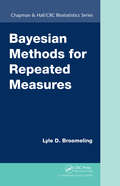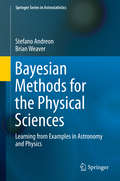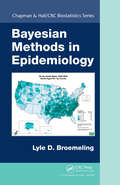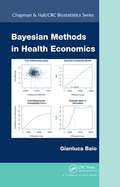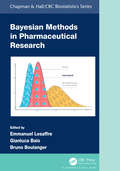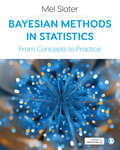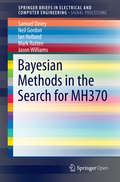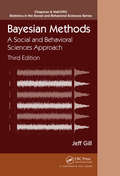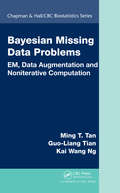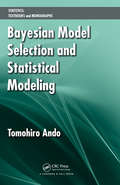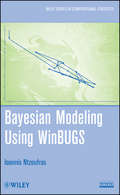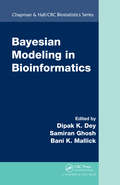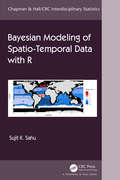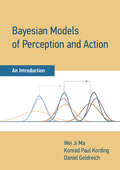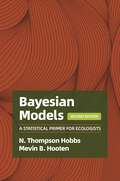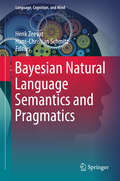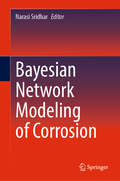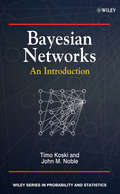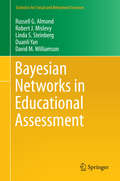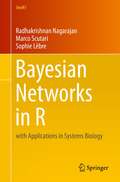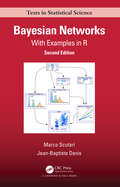- Table View
- List View
Bayesian Methods for Repeated Measures (Chapman & Hall/CRC Biostatistics Series)
by Lyle D. BroemelingAnalyze Repeated Measures Studies Using Bayesian TechniquesGoing beyond standard non-Bayesian books, Bayesian Methods for Repeated Measures presents the main ideas for the analysis of repeated measures and associated designs from a Bayesian viewpoint. It describes many inferential methods for analyzing repeated measures in various scientific areas,
Bayesian Methods for the Physical Sciences: Learning from Examples in Astronomy and Physics (Springer Series in Astrostatistics #4)
by Stefano Andreon Brian WeaverStatistical literacy is critical for the modern researcher in Physics and Astronomy. This book empowers researchers in these disciplines by providing the tools they will need to analyze their own data. Chapters in this book provide a statistical base from which to approach new problems, including numerical advice and a profusion of examples. The examples are engaging analyses of real-world problems taken from modern astronomical research. The examples are intended to be starting points for readers as they learn to approach their own data and research questions. Acknowledging that scientific progress now hinges on the availability of data and the possibility to improve previous analyses, data and code are distributed throughout the book. The JAGS symbolic language used throughout the book makes it easy to perform Bayesian analysis and is particularly valuable as readers may use it in a myriad of scenarios through slight modifications. This book is comprehensive, well written, and will surely be regarded as a standard text in both astrostatistics and physical statistics. Joseph M. Hilbe, President, International Astrostatistics Association, Professor Emeritus, University of Hawaii, and Adjunct Professor of Statistics, Arizona State University
Bayesian Methods in Epidemiology (Chapman & Hall/CRC Biostatistics Series)
by Lyle D. BroemelingWritten by a biostatistics expert with over 20 years of experience in the field, Bayesian Methods in Epidemiology presents statistical methods used in epidemiology from a Bayesian viewpoint. It employs the software package WinBUGS to carry out the analyses and offers the code in the text and for download online.The book examines study designs that
Bayesian Methods in Health Economics (Chapman & Hall/CRC Biostatistics Series)
by Gianluca BaioHealth economics is concerned with the study of the cost-effectiveness of health care interventions. This book provides an overview of Bayesian methods for the analysis of health economic data. After an introduction to the basic economic concepts and methods of evaluation, it presents Bayesian statistics using accessible mathematics. The next chapters describe the theory and practice of cost-effectiveness analysis from a statistical viewpoint, and Bayesian computation, notably MCMC. The final chapter presents three detailed case studies covering cost-effectiveness analyses using individual data from clinical trials, evidence synthesis and hierarchical models and Markov models. The text uses WinBUGS and JAGS with datasets and code available online.
Bayesian Methods in Pharmaceutical Research (Chapman & Hall/CRC Biostatistics Series)
by Emmanuel Lesaffre, Gianluca Baio and Bruno BoulangerSince the early 2000s, there has been increasing interest within the pharmaceutical industry in the application of Bayesian methods at various stages of the research, development, manufacturing, and health economic evaluation of new health care interventions. In 2010, the first Applied Bayesian Biostatistics conference was held, with the primary objective to stimulate the practical implementation of Bayesian statistics, and to promote the added-value for accelerating the discovery and the delivery of new cures to patients. This book is a synthesis of the conferences and debates, providing an overview of Bayesian methods applied to nearly all stages of research and development, from early discovery to portfolio management. It highlights the value associated with sharing a vision with the regulatory authorities, academia, and pharmaceutical industry, with a view to setting up a common strategy for the appropriate use of Bayesian statistics for the benefit of patients. The book covers: Theory, methods, applications, and computing Bayesian biostatistics for clinical innovative designs Adding value with Real World Evidence Opportunities for rare, orphan diseases, and pediatric development Applied Bayesian biostatistics in manufacturing Decision making and Portfolio management Regulatory perspective and public health policies Statisticians and data scientists involved in the research, development, and approval of new cures will be inspired by the possible applications of Bayesian methods covered in the book. The methods, applications, and computational guidance will enable the reader to apply Bayesian methods in their own pharmaceutical research.
Bayesian Methods in Statistics: From Concepts to Practice
by Mel SlaterThis book walks you through learning probability and statistics from a Bayesian point of view. From an introduction to probability theory through to frameworks for doing rigorous calculations of probability, it discusses Bayes’ Theorem before illustrating how to use it in a variety of different situations with data addressing social and psychological issues. The book also: Equips you with coding skills in the statistical modelling language Stan and programming language R. Discusses how Bayesian approaches to statistics compare to classical approaches. Introduces Markov Chain Monte Carlo methods for doing Bayesian statistics through computer simulations, so you understand how Bayesian solutions are implemented. Features include an introduction to each chapter and a chapter summary to help you check your learning. All the examples and data used in the book are also available in the online resources so you can practice at your own pace. For readers with some understanding of basic mathematical functions and notation, this book will get you up and running so you can do Bayesian statistics with confidence.
Bayesian Methods in Statistics: From Concepts to Practice
by Mel SlaterThis book walks you through learning probability and statistics from a Bayesian point of view. From an introduction to probability theory through to frameworks for doing rigorous calculations of probability, it discusses Bayes’ Theorem before illustrating how to use it in a variety of different situations with data addressing social and psychological issues. The book also: Equips you with coding skills in the statistical modelling language Stan and programming language R. Discusses how Bayesian approaches to statistics compare to classical approaches. Introduces Markov Chain Monte Carlo methods for doing Bayesian statistics through computer simulations, so you understand how Bayesian solutions are implemented. Features include an introduction to each chapter and a chapter summary to help you check your learning. All the examples and data used in the book are also available in the online resources so you can practice at your own pace. For readers with some understanding of basic mathematical functions and notation, this book will get you up and running so you can do Bayesian statistics with confidence.
Bayesian Methods in the Search for MH370 (SpringerBriefs in Electrical and Computer Engineering)
by Neil Gordon Jason Williams Sam Davey Ian Holland Mark RuttenThis book demonstrates how nonlinear/non-Gaussian Bayesian time series estimation methods were used to produce a probability distribution of potential MH370 flight paths. It provides details of how the probabilistic models of aircraft flight dynamics, satellite communication system measurements, environmental effects and radar data were constructed and calibrated. The probability distribution was used to define the search zone in the southern Indian Ocean.The book describes particle-filter based numerical calculation of the aircraft flight-path probability distribution and validates the method using data from several of the involved aircraft’s previous flights. Finally it is shown how the Reunion Island flaperon debris find affects the search probability distribution.
Bayesian Methods: A Social and Behavioral Sciences Approach, Third Edition (Chapman & Hall/CRC Statistics in the Social and Behavioral Sciences)
by Jeff GillAn Update of the Most Popular Graduate-Level Introductions to Bayesian Statistics for Social ScientistsNow that Bayesian modeling has become standard, MCMC is well understood and trusted, and computing power continues to increase, Bayesian Methods: A Social and Behavioral Sciences Approach, Third Edition focuses more on implementation details of th
Bayesian Missing Data Problems: EM, Data Augmentation and Noniterative Computation
by Kai Wang Ng Guo-Liang Tian Ming T. TanBayesian Missing Data Problems: EM, Data Augmentation and Noniterative Computation presents solutions to missing data problems through explicit or noniterative sampling calculation of Bayesian posteriors. The methods are based on the inverse Bayes formulae discovered by one of the author in 1995. Applying the Bayesian approach to important real-wor
Bayesian Model Selection and Statistical Modeling
by Tomohiro AndoAlong with many practical applications, Bayesian Model Selection and Statistical Modeling presents an array of Bayesian inference and model selection procedures. It thoroughly explains the concepts, illustrates the derivations of various Bayesian model selection criteria through examples, and provides R code for implementation. The author shows how
Bayesian Modeling Using WinBUGS
by Ioannis NtzoufrasA hands-on introduction to the principles of Bayesian modeling using WinBUGSBayesian Modeling Using WinBUGS provides an easily accessible introduction to the use of WinBUGS programming techniques in a variety of Bayesian modeling settings. The author provides an accessible treatment of the topic, offering readers a smooth introduction to the principles of Bayesian modeling with detailed guidance on the practical implementation of key principles.The book begins with a basic introduction to Bayesian inference and the WinBUGS software and goes on to cover key topics, including:Markov Chain Monte Carlo algorithms in Bayesian inferenceGeneralized linear modelsBayesian hierarchical modelsPredictive distribution and model checkingBayesian model and variable evaluationComputational notes and screen captures illustrate the use of both WinBUGS as well as R software to apply the discussed techniques. Exercises at the end of each chapter allow readers to test their understanding of the presented concepts and all data sets and code are available on the book's related Web site.Requiring only a working knowledge of probability theory and statistics, Bayesian Modeling Using WinBUGS serves as an excellent book for courses on Bayesian statistics at the upper-undergraduate and graduate levels. It is also a valuable reference for researchers and practitioners in the fields of statistics, actuarial science, medicine, and the social sciences who use WinBUGS in their everyday work.
Bayesian Modeling and Computation in Python (Chapman & Hall/CRC Texts in Statistical Science)
by Osvaldo A. Martin Ravin Kumar Junpeng LaoBayesian Modeling and Computation in Python aims to help beginner Bayesian practitioners to become intermediate modelers. It uses a hands on approach with PyMC3, Tensorflow Probability, ArviZ and other libraries focusing on the practice of applied statistics with references to the underlying mathematical theory. The book starts with a refresher of the Bayesian Inference concepts. The second chapter introduces modern methods for Exploratory Analysis of Bayesian Models. With an understanding of these two fundamentals the subsequent chapters talk through various models including linear regressions, splines, time series, Bayesian additive regression trees. The final chapters include Approximate Bayesian Computation, end to end case studies showing how to apply Bayesian modelling in different settings, and a chapter about the internals of probabilistic programming languages. Finally the last chapter serves as a reference for the rest of the book by getting closer into mathematical aspects or by extending the discussion of certain topics. This book is written by contributors of PyMC3, ArviZ, Bambi, and Tensorflow Probability among other libraries.
Bayesian Modeling in Bioinformatics (Chapman & Hall/CRC Biostatistics Series)
by Bani K. Mallick Dipak K. Dey Samiran GhoshBayesian Modeling in Bioinformatics discusses the development and application of Bayesian statistical methods for the analysis of high-throughput bioinformatics data arising from problems in molecular and structural biology and disease-related medical research, such as cancer. It presents a broad overview of statistical inference, clustering, and c
Bayesian Modeling of Spatio-Temporal Data with R (Chapman & Hall/CRC Interdisciplinary Statistics)
by Sujit SahuApplied sciences, both physical and social, such as atmospheric, biological, climate, demographic, economic, ecological, environmental, oceanic and political, routinely gather large volumes of spatial and spatio-temporal data in order to make wide ranging inference and prediction. Ideally such inferential tasks should be approached through modelling, which aids in estimation of uncertainties in all conclusions drawn from such data. Unified Bayesian modelling, implemented through user friendly software packages, provides a crucial key to unlocking the full power of these methods for solving challenging practical problems. Key features of the book: • Accessible detailed discussion of a majority of all aspects of Bayesian methods and computations with worked examples, numerical illustrations and exercises • A spatial statistics jargon buster chapter that enables the reader to build up a vocabulary without getting clouded in modeling and technicalities • Computation and modeling illustrations are provided with the help of the dedicated R package bmstdr, allowing the reader to use well-known packages and platforms, such as rstan, INLA, spBayes, spTimer, spTDyn, CARBayes, CARBayesST, etc • Included are R code notes detailing the algorithms used to produce all the tables and figures, with data and code available via an online supplement • Two dedicated chapters discuss practical examples of spatio-temporal modeling of point referenced and areal unit data • Throughout, the emphasis has been on validating models by splitting data into test and training sets following on the philosophy of machine learning and data science This book is designed to make spatio-temporal modeling and analysis accessible and understandable to a wide audience of students and researchers, from mathematicians and statisticians to practitioners in the applied sciences. It presents most of the modeling with the help of R commands written in a purposefully developed R package to facilitate spatio-temporal modeling. It does not compromise on rigour, as it presents the underlying theories of Bayesian inference and computation in standalone chapters, which would be appeal those interested in the theoretical details. By avoiding hard core mathematics and calculus, this book aims to be a bridge that removes the statistical knowledge gap from among the applied scientists.
Bayesian Models of Perception and Action: An Introduction
by Wei Ji Ma Konrad Paul Kording Daniel GoldreichAn accessible introduction to constructing and interpreting Bayesian models of perceptual decision-making and action.Many forms of perception and action can be mathematically modeled as probabilistic—or Bayesian—inference, a method used to draw conclusions from uncertain evidence. According to these models, the human mind behaves like a capable data scientist or crime scene investigator when dealing with noisy and ambiguous data. This textbook provides an approachable introduction to constructing and reasoning with probabilistic models of perceptual decision-making and action. Featuring extensive examples and illustrations, Bayesian Models of Perception and Action is the first textbook to teach this widely used computational framework to beginners.Introduces Bayesian models of perception and action, which are central to cognitive science and neuroscienceBeginner-friendly pedagogy includes intuitive examples, daily life illustrations, and gradual progression of complex conceptsBroad appeal for students across psychology, neuroscience, cognitive science, linguistics, and mathematicsWritten by leaders in the field of computational approaches to mind and brain
Bayesian Models: A Statistical Primer for Ecologists, 2nd Edition
by N. Thompson Hobbs Mevin B. HootenA fully updated and expanded edition of the essential primer on Bayesian modeling for ecologistsUniquely suited to deal with complexity in a statistically coherent way, Bayesian modeling has become an indispensable tool for ecological research. This book teaches the basic principles of mathematics and statistics needed to apply Bayesian models to the analysis of ecological data, using language non-statisticians can understand. Deemphasizing computer coding in favor of a clear treatment of model building, it starts with a definition of probability and proceeds step-by-step through distribution theory, likelihood, simple Bayesian models, and hierarchical Bayesian models. Now revised and expanded, Bayesian Models enables students and practitioners to gain new insights from ecological models and data properly tempered by uncertainty.Covers the basic rules of probability needed to model diverse types of ecological data in the Bayesian frameworkShows how to write proper mathematical expressions for posterior distributions using directed acyclic graphs as templatesExplains how to use the powerful Markov chain Monte Carlo algorithm to find posterior distributions of model parameters, latent states, and missing dataTeaches how to check models to assure they meet the assumptions of model-based inferenceDemonstrates how to make inferences from single and multiple Bayesian modelsProvides worked problems for practicing and strengthening modeling skillsFeatures new chapters on spatial models and modeling missing data
Bayesian Natural Language Semantics and Pragmatics (Language, Cognition, and Mind #2)
by Henk Zeevat Hans-Christian SchmitzThe contributions in this volume focus on the Bayesian interpretation of natural languages, which is widely used in areas of artificial intelligence, cognitive science, and computational linguistics. This is the first volume to take up topics in Bayesian Natural Language Interpretation and make proposals based on information theory, probability theory, and related fields. The methodologies offered here extend to the target semantic and pragmatic analyses of computational natural language interpretation. Bayesian approaches to natural language semantics and pragmatics are based on methods from signal processing and the causal Bayesian models pioneered by especially Pearl. In signal processing, the Bayesian method finds the most probable interpretation by finding the one that maximizes the product of the prior probability and the likelihood of the interpretation. It thus stresses the importance of a production model for interpretation as in Grice's contributions to pragmatics or in interpretation by abduction.
Bayesian Network Modeling of Corrosion
by Narasi SridharThis book represents a compilation of experience from a slate of experts involved in developing and deploying Bayesian Networks (BN) for corrosion management. The contributors describe how probability distributions can be developed for corroding systems and BN can be applied as an ideal framework to deal with corrosion risk. Corrosion can develop suddenly and grow rapidly after a long incubation period and take many non-uniform aspects, including pitting and stress corrosion cracking, that cannot be mitigated by simply bulking up the system. They also describe how complex engineering structures and systems are influenced by many natural and engineering factors that come together in myriad ways. It provides a broad perspective to the reader on the potential of BN as an artificial intelligence tool for corrosion risk management and the challenges for implementing it.
Bayesian Networks
by John Noble Timo KoskiBayesian Networks: An Introduction provides a self-contained introduction to the theory and applications of Bayesian networks, a topic of interest and importance for statisticians, computer scientists and those involved in modelling complex data sets. The material has been extensively tested in classroom teaching and assumes a basic knowledge of probability, statistics and mathematics. All notions are carefully explained and feature exercises throughout.Features include:An introduction to Dirichlet Distribution, Exponential Families and their applications.A detailed description of learning algorithms and Conditional Gaussian Distributions using Junction Tree methods.A discussion of Pearl's intervention calculus, with an introduction to the notion of see and do conditioning.All concepts are clearly defined and illustrated with examples and exercises. Solutions are provided online.This book will prove a valuable resource for postgraduate students of statistics, computer engineering, mathematics, data mining, artificial intelligence, and biology.Researchers and users of comparable modelling or statistical techniques such as neural networks will also find this book of interest.
Bayesian Networks and Influence Diagrams: A Guide To Construction And Analysis (Information Science and Statistics #22)
by Uffe B. Kjærulff Anders L. MadsenBayesian Networks and Influence Diagrams: A Guide to Construction and Analysis, Second Edition, provides a comprehensive guide for practitioners who wish to understand, construct, and analyze intelligent systems for decision support based on probabilistic networks. This new edition contains six new sections, in addition to fully-updated examples, tables, figures, and a revised appendix. Intended primarily for practitioners, this book does not require sophisticated mathematical skills or deep understanding of the underlying theory and methods nor does it discuss alternative technologies for reasoning under uncertainty. The theory and methods presented are illustrated through more than 140 examples, and exercises are included for the reader to check his or her level of understanding. The techniques and methods presented for knowledge elicitation, model construction and verification, modeling techniques and tricks, learning models from data, and analyses of models have all been developed and refined on the basis of numerous courses that the authors have held for practitioners worldwide.
Bayesian Networks for Probabilistic Inference and Decision Analysis in Forensic Science
by Colin Aitken Silvia Bozza Paolo Garbolino Franco Taroni Alex Biedermann"This book should have a place on the bookshelf of every forensic scientist who cares about the science of evidence interpretation" Dr. Ian Evett, Principal Forensic Services Ltd, London, UK Continuing developments in science and technology mean that the amounts of information forensic scientists are able to provide for criminal investigations is ever increasing. The commensurate increase in complexity creates difficulties for scientists and lawyers with regard to evaluation and interpretation, notably with respect to issues of inference and decision. Probability theory, implemented through graphical methods, and specifically Bayesian networks, provides powerful methods to deal with this complexity. Extensions of these methods to elements of decision theory provide further support and assistance to the judicial system. Bayesian Networks for Probabilistic Inference and Decision Analysis in Forensic Science provides a unique and comprehensive introduction to the use of Bayesian decision networks for the evaluation and interpretation of scientific findings in forensic science, and for the support of decision-makers in their scientific and legal tasks. * Includes self-contained introductions to probability and decision theory. * Develops the characteristics of Bayesian networks, object-oriented Bayesian networks and their extension to decision models. * Features implementation of the methodology with reference to commercial and academically available software. * Presents standard networks and their extensions that can be easily implemented and that can assist in the reader's own analysis of real cases. * Provides a technique for structuring problems and organizing data based on methods and principles of scientific reasoning. * Contains a method for the construction of coherent and defensible arguments for the analysis and evaluation of scientific findings and for decisions based on them. * Is written in a lucid style, suitable for forensic scientists and lawyers with minimal mathematical background. * Includes a foreword by Ian Evett. The clear and accessible style of this second edition makes this book ideal for all forensic scientists, applied statisticians and graduate students wishing to evaluate forensic findings from the perspective of probability and decision analysis. It will also appeal to lawyers and other scientists and professionals interested in the evaluation and interpretation of forensic findings, including decision making based on scientific information.
Bayesian Networks in Educational Assessment (Statistics for Social and Behavioral Sciences)
by Russell G. Almond Robert J. Mislevy Linda S. Steinberg Duanli Yan David M. WilliamsonBayesian inference networks, a synthesis of statistics and expert systems, have advanced reasoning under uncertainty in medicine, business, and social sciences. This innovative volume is the first comprehensive treatment exploring how they can be applied to design and analyze innovative educational assessments. Part I develops Bayes nets' foundations in assessment, statistics, and graph theory, and works through the real-time updating algorithm. Part II addresses parametric forms for use with assessment, model-checking techniques, and estimation with the EM algorithm and Markov chain Monte Carlo (MCMC). A unique feature is the volume's grounding in Evidence-Centered Design (ECD) framework for assessment design. This "design forward" approach enables designers to take full advantage of Bayes nets' modularity and ability to model complex evidentiary relationships that arise from performance in interactive, technology-rich assessments such as simulations. Part III describes ECD, situates Bayes nets as an integral component of a principled design process, and illustrates the ideas with an in-depth look at the BioMass project: An interactive, standards-based, web-delivered demonstration assessment of science inquiry in genetics. This book is both a resource for professionals interested in assessment and advanced students. Its clear exposition, worked-through numerical examples, and demonstrations from real and didactic applications provide invaluable illustrations of how to use Bayes nets in educational assessment. Exercises follow each chapter, and the online companion site provides a glossary, data sets and problem setups, and links to computational resources.
Bayesian Networks in R: with Applications in Systems Biology (Use R! #48)
by Marco Scutari Radhakrishnan Nagarajan Sophie LèbreBayesian Networks in R with Applications in Systems Biology is unique as it introduces the reader to the essential concepts in Bayesian network modeling and inference in conjunction with examples in the open-source statistical environment R. The level of sophistication is also gradually increased across the chapters with exercises and solutions for enhanced understanding for hands-on experimentation of the theory and concepts. The application focuses on systems biology with emphasis on modeling pathways and signaling mechanisms from high-throughput molecular data. Bayesian networks have proven to be especially useful abstractions in this regard. Their usefulness is especially exemplified by their ability to discover new associations in addition to validating known ones across the molecules of interest. It is also expected that the prevalence of publicly available high-throughput biological data sets may encourage the audience to explore investigating novel paradigms using the approaches presented in the book.
Bayesian Networks: With Examples in R (Chapman & Hall/CRC Texts in Statistical Science #109)
by Marco Scutari Jean-Baptiste DenisBayesian Networks: With Examples in R, Second Edition introduces Bayesian networks using a hands-on approach. Simple yet meaningful examples illustrate each step of the modelling process and discuss side-by-side the underlying theory and its application using R code. The examples start from the simplest notions and gradually increase in complexity. In particular, this new edition contains significant new material on topics from modern machine learning practice: dynamic networks, networks with heterogeneous variables, and model validation. The first three chapters explain the whole process of Bayesian network modelling, from structure learning to parameter learning to inference. These chapters cover discrete, Gaussian, and conditional Gaussian Bayesian networks. The following two chapters delve into dynamic networks (to model temporal data) and into networks including arbitrary random variables (using Stan). The book then gives a concise but rigorous treatment of the fundamentals of Bayesian networks and offers an introduction to causal Bayesian networks. It also presents an overview of R packages and other software implementing Bayesian networks. The final chapter evaluates two real-world examples: a landmark causal protein-signaling network published in Science and a probabilistic graphical model for predicting the composition of different body parts. Covering theoretical and practical aspects of Bayesian networks, this book provides you with an introductory overview of the field. It gives you a clear, practical understanding of the key points behind this modelling approach and, at the same time, it makes you familiar with the most relevant packages used to implement real-world analyses in R. The examples covered in the book span several application fields, data-driven models and expert systems, probabilistic and causal perspectives, thus giving you a starting point to work in a variety of scenarios. Online supplementary materials include the data sets and the code used in the book, which will all be made available from https://www.bnlearn.com/book-crc-2ed/
